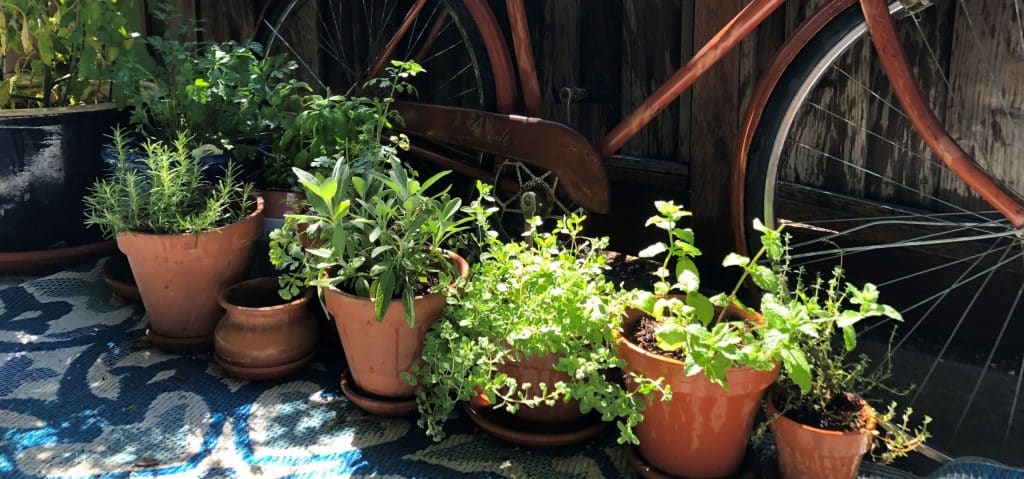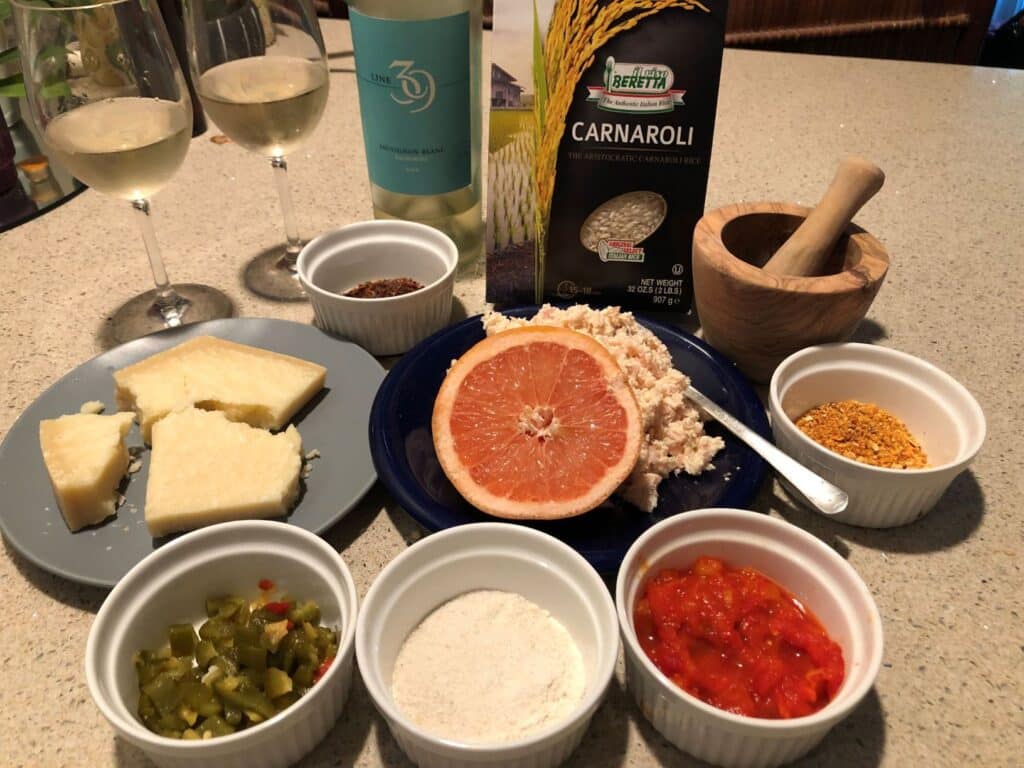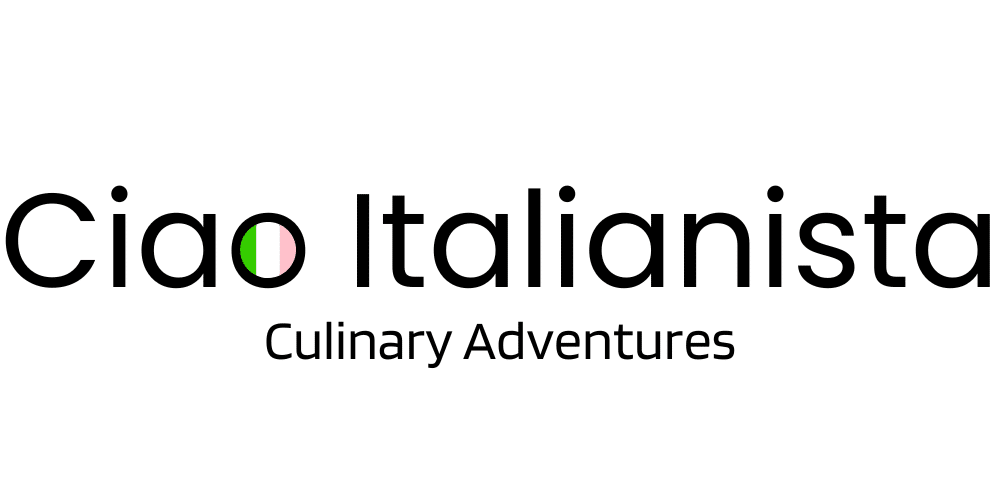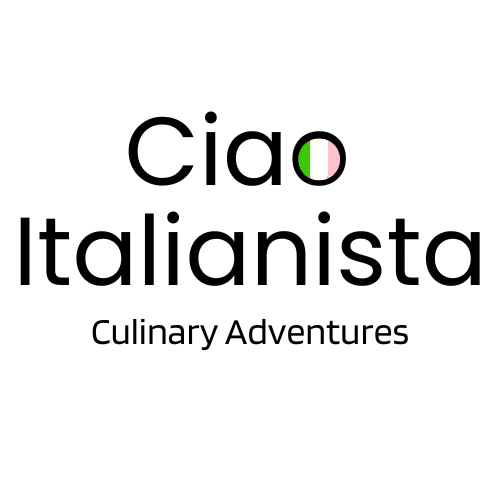Ciao Italianista contains affiliate links and is a member of the Amazon Services LLS Associates Program. If you make a purchase using one of these Amazon links, I may receive compensation at no extra charge to you. See my disclosure policy for more information.
Best Roasted Pepper Risotto Ever in 7 Easy Steps

I learned these 7 steps for making this delicious roasted pepper risotto in an online cooking class. While teaching us how to make the risotto, chef Antonia Klugmann and Maddalena Fossati, the director of La Cucina Italiana, had an interesting conversation about contemporary Italian cuisine.
La Cucina Italiana has plans to open an online cooking school, but until then, they hold live virtual culinary experiences like this one. It was on the My Authentic Italian Table YouTube channel.
I learned so much about modern Italian cuisine making from their conversation and how to make roasted pepper risotto in a healthy and sustainable way.
Best roasted pepper risotto ever in 7 easy steps
1. Grow your own veggies
The first secret ingredient to make roasted pepper risotto begins with the idea of growing your own veggies and not wasting anything. Of course, this is not a new idea, but one that goes way back to the beginning of time in Italian cooking.
2. Use all the parts of the pepper
Italian cooking has always been a cucina povera, a poor person’s cuisine, meaning the cuisine of the people. So nothing is wasted and whatever is available is used.
I’ve talked about the idea of cucina povera before, and most recently in this article about tortellini. And previously on this site about Tyrolean cuisine.
This is a good lesson for me but not an easy one. When I make Italian cuisine, my idea of it being authentic is using real Italian top-quality ingredients even if it means spending a lot of money.
What I have learned by making this risotto is that, yes, always use top-quality ingredients in Italian cooking but that I need to be more flexible in my thinking about how far that obsession goes. And when I do spend a lot of money on top-quality ingredients, the main thing I need to do is have gratitude and appreciation for everything that went into making this amazing product.
3. Have appreciation and gratitude
The new contemporary Italian cooking understands the suppliers and producers and how difficult it was to make their product. When you have this attitude of appreciation and understanding, then the cost of a top-quality ingredient like Parmigiano Reggiano is actually very reasonable.
Like I said, I have no problem spending a lot of money on top-quality ingredients to make my Italian dishes. But where I need to be more flexible is in understanding that I can substitute a local top-quality ingredient instead of adding all the transportation costs to my top-quality ingredients and I will still be making authentic Italian cuisine.
The most local of all is to grow your own veggies. Or if that is not possible, you can at least grow your own herbs. Italian cuisine uses so many fresh herbs. I planted basil, rosemary, thyme, mint, marjoram, cilantro, parsley, and sage on my small patio. Here is a photo of my Italian herb garden:

Modern authentic Italian cuisine is also trying to use more vegetables and less meat protein to be healthier and more sustainable. And it’s about using every part of the vegetable and wasting nothing.
This method for cooking risotto shows how to use every part of the pepper: the skins, the seeds, the flesh, and the juices. Nothing is wasted. And you need to see the ingredients not as objects, but as a living thing with a history. So when you go to the store to buy the peppers (if you can’t grow them yourself), handle them with awe and admiration and think about their story from seed on the farm to beautiful fruit in the store and now in your shopping cart.
The ingredients and the recipe
Now it is time to make the roasted pepper risotto! Here are the ingredients to make this delicious, sustainable, healthy, authentic risotto:
- Carnaroli rice (This is a type of rice, not a brand.)
- Peppers (red, yellow, and jalapeño ). The word for jalapeño in Italian is frigitello.
- Ruby red grapefruit
- Shallots (called scallonio in Italian)
- White wine
- Parmigiano Reggiano

4. Roast the peppers
The first thing is to roast the peppers so that you can de-skin them and separate the flesh from the juices and seeds. Antonia shows three different methods for preparing the peppers. I just did the one where you put a thick layer of course salt on a tray and put the peppers on top. Then you roast them for ten minutes on both sides at the highest temperature your oven will go. I also ended with a minute on broil.
When they are roasted, remove the peppers from the oven and put them in a plastic bag until cool. Once they are cool, just slip off the skins and put the skins outside in the sun to dry. Make sure the rest of the pepper all lands in a bowl. Now open up the peppers and let all the juices and seeds run into the bowl. Save the juice to use as a liquid in the risotto. Take the baked, skinned, de-seeded peppers and put them into a blender to make a purée .
5. Make the burro acido
While the pepper skins are drying (they will be used to make a powder that goes into the risotto), make the burro acido. This is the secret ingredient for roasted pepper risotto. I had never heard of burro acido before making this risotto and it is the most amazing thing ever.
You can make it for this risotto and there will be a lot leftover that you can use for many other things. I often just make a piece of toast and spread the burro acido on top like a very flavorful cream cheese.
To make the burro acido, chop up the shallots, sauté them with a little butter, then cover with a half-liter of white wine. Boil until the wine is reduced to almost nothing. Then put the reduced wine shallot base into the blender, add salted butter (a lot), squeeze half of the grapefruit juice in, and blend. Now you have burro acido. Put this aside.
If the pepper skins are dry, make the powders. Just put the dry skins in a grinder or blender and make them into a powder. I also baked the grapefruit peel and once it was dried out, I crushed it into a powder. The aroma is amazing.
6. Cook the rice
Now it’s time to cook the rice. Put a little olive oil and salt in the pan and then put in the rice. The Italians measure rice with a pugno, or fist. So just put about 4 handfuls (pugni) into the pan and heat it up until it is hot to the touch. This step is crucial because it changes the shape of the rice ever so slightly. You want to make sure the tostatura (toasting) of the rice is hot but that the rice does not turn brown.
Now add a few ladles of hot water. You need to have the water heating in another pot and you will just add ladles of the hot water as needed. Now add a pinch of rice powder. You grind up some of the rice into a powder and add this to the cooking rice. Whisk in the rice powder as the water is started to boil.
7. Master the roasted pepper risotto technique
This technique of whisking is so important and has to be done just right. The Italians call it mantecare. How you do the mixing or mantecare is so important that Antonia invented a new English word called “to mantecate”. Now you also add the juice of the peppers and mantecate bene! . In this modern authentic Italian cuisine, Antonia is using the juices of the peppers instead of stock which is more traditionally used. I used both because I just happen to have some juices from a freshly roasted chicken on hand.
Now add the pepper purée. Turn off the heat and remove the pan from the burner. It’s time to add the burro acido and the Parmigiano Reggiano. Whenever you add the fat, the risotto has to be off the heat. The risotto is finished and it’s time to plate it!

Put a serving of the risotto onto the plate. Sprinkle it with the pepper and grapefruit powders you made. Add some of the chopped roasted frigitello (jalapeño). And now inhale the aromas and taste the risotto. Think about all that went into this amazing healthy sustainable Italian risotto and how you used all the parts of the peppers and grapefruit.
This roasted pepper risotto dish is so simple and so tasty. It’s real and authentic and not very expensive. And you learn so many amazing tips about Italian cuisine like how to stir properly (mantecare) and how to make burro acido. I hope you give it a try.

Roasted Pepper Risotto
Ingredients
- 3 peppers
- 3 shallots
- 1/2 liter white wine
- butter salted
- 1 grapefruit ruby red
- 1 tbsp olive oil extra virgin
- 4 handfuls rice Carnaroli
- Parmigiano Reggiano cheese
Instructions
Roast the peppers
- Roast the peppers. Put a thick layer of course salt on a tray and put the peppers on top. Roast for 10 minutes at the highest temperature your oven will go.
- After they are roasted, put the peppers in a plastic bag until cool. Once they are cool, slip off the skins and put the skins outside in the sun to dry.
- Put the rest of the peppers in a bowl. Open up the peppers and let the juices and seeds run into the bowl. Save the juice to use as a liquid to add to the risotto.
- Put the skinned, de-seeded peppers in the blender. Blend into a puree.
Make the burro acido
- Chop the shallots. Sauté the shallots in butter.
- After sautéing the shallots, cover them with the wine. Boil until the wine is reduced to almost nothing.
- Put the reduced wine shallot base into the blender. Add a lot of salted butter. Squeeze half of the grapefruit juice in. Blend. Remove from blender and put aside.
Make the powders
- Put the dry pepper skins in a grinder or blender and make them into a powder. Bake some of the grapefruit peel and grind it into a powder.
Cook the rice
- Put some olive oil and salt in the pan. Then put in the rice. Heat it until it is hot to the touch.
- Add a few ladles of hot water that was heated in a separate pot.
- Grind up some rice that is not in the pot to make a powder.
- Whisk the rice powder into the cooking rice as the water is starting to boil.
- Add the juice of the peppers and whisk some more.
- Add the pepper purée.
- Turn off the heat and remove the pan from the burner.
- Add the burro acido and the Parmigiano Reggiano cheese. The risotto is finished.
Plate the risotto
- Put a serving of the risotto on a plate. Sprinkle it with the pepper and grapefruit powders. Add some of the chopped roasted jalapeno.

